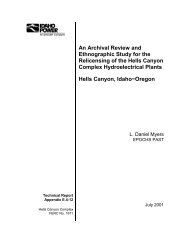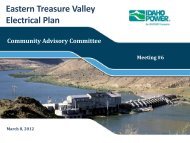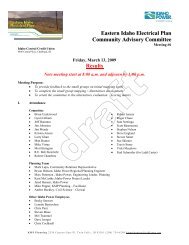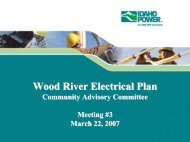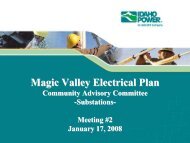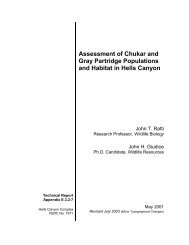Shoshone-Bannock Tribes - Idaho Power
Shoshone-Bannock Tribes - Idaho Power
Shoshone-Bannock Tribes - Idaho Power
Create successful ePaper yourself
Turn your PDF publications into a flip-book with our unique Google optimized e-Paper software.
Responses to Comments<strong>Idaho</strong> <strong>Power</strong> Company<strong>Shoshone</strong>-<strong>Bannock</strong> <strong>Tribes</strong> were invited to participate in an oral history study but declined theinvitation.Due to some unanticipated delays, the completion date for the Nez Perce Tribe’s ethnographicstudy has been extended. The document is currently in the final review phase and will not besubmitted with the FLA. IPC will notify the appropriate agencies and tribes when the reportbecomes available.RESPONSE TO COMMENT SBT1-187Two of the three completed tribal ethnographic studies have addressed botanical resources.Because of the confidential nature of these reports, they were provided to the land managementagencies only. The <strong>Shoshone</strong>-<strong>Bannock</strong> <strong>Tribes</strong> may obtain a copy of these reports by contactingthe BLM or USFS.An attempt was made to work with the <strong>Shoshone</strong>-<strong>Bannock</strong> and <strong>Shoshone</strong>-Paiute tribes todevelop ethnographic projects. IPC proposed an ethnobotanical field school at Bancroft Springswith the <strong>Shoshone</strong>-<strong>Bannock</strong> <strong>Tribes</strong> in connection with relicensing efforts for Mid-Snakeprojects. In the Mid-Snake new license application, the company proposed a 375-acre researchpreserve on land it owns at Bancroft Springs. In response to <strong>Shoshone</strong>-<strong>Bannock</strong> tribal staffrequests, IPC offered access to the tribes to be used as a field school for <strong>Shoshone</strong>-<strong>Bannock</strong>tribal members. A field trip to the preserve took place in March 2000 with cultural anthropologistKristin Ruppel, Director of the <strong>Shoshone</strong>-<strong>Bannock</strong> Tribal AmeriCorps/InPEACE program;several AmeriCorps participants; and IPC representatives Mark Druss, Allan Ansell, and RobynJohnson. Despite IPC’s effort to provide this opportunity to the <strong>Shoshone</strong>-<strong>Bannock</strong> <strong>Tribes</strong>, thetribal government decided not to pursue the project. The project never went forward.IPC will work within the framework of treaties and other existing laws and regulations asappropriate to address plant resources in which the tribes have a legitimate interest.RESPONSE TO COMMENT SBT1-188IPC’s philosophy is to not abandon consultation, but to work through conflicts. An importantfirst step is to lay the groundwork for initial meetings through ongoing contacts so thatpotentially interested parties are aware of proposed actions on the part of IPC. Parties with nointerest in a specific project can express this prior to engaging in time-consuming meetings,saving their efforts for discussions that are relevant to their concerns.Consultation will precede unavoidable adverse effects on historic properties, as part of thesection 106 process required for all federal undertakings. It will also be a general method ofcultural resource management by IPC, wherein open lines of communication should helpmanagement practices run smoothly.Internally, IPC personnel who initiate and are responsible for ground-disturbing activities willapprise the cultural resources manager of a proposed action (see the HPMP [or TechnicalReport E.4-15], Figure 4.3-b). If the action is on private land, the cultural resources manager willconsult with the landowner to allow the management process to continue. The cultural resourcesmanager will determine whether Native Americans have an interest in the proposed action,Page 76Hells Canyon Complex



